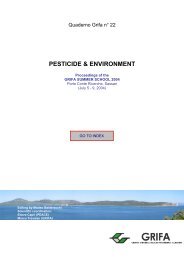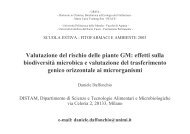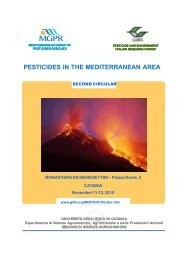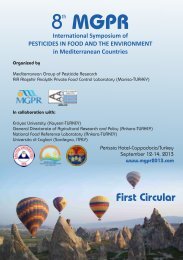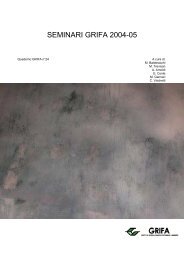International Congress BIOLOGICAL PRODUCTS - Gruppo di ...
International Congress BIOLOGICAL PRODUCTS - Gruppo di ...
International Congress BIOLOGICAL PRODUCTS - Gruppo di ...
You also want an ePaper? Increase the reach of your titles
YUMPU automatically turns print PDFs into web optimized ePapers that Google loves.
(mg kg-1)<br />
(mg kg-1)<br />
140<br />
120<br />
100<br />
80<br />
60<br />
40<br />
20<br />
0<br />
120<br />
100<br />
80<br />
60<br />
40<br />
20<br />
0<br />
b<br />
N-NO3 NaHCO3-P Exch.-K<br />
b<br />
n.s. n.s.<br />
b<br />
a<br />
Soil available nutrients<br />
a<br />
n.s.<br />
Zn Cu Pb<br />
Soil heavy metals<br />
b<br />
a<br />
b b b<br />
n.s.<br />
CONTR.<br />
F.MPHOS<br />
Soil properties reported in the Table 2 show that experimental treatments play a similar role on pH and<br />
CEC. The degree of humification (DH) results significantly higher in “R.S.-treated” plots than in<br />
“control” plots; on the other hand in “fenamiphos-” and “FOPC-treated” plots this parameter appears very lower<br />
than in “control” plots. Humification rate<br />
(HR) in all treated plots is lower than control. Finally humification index (HI) of “fenamiphos-“ and “FOPC-“ treated<br />
plots is higher than other plots similarly to the fin<strong>di</strong>ngs of degree of humification (DH).<br />
Table 2 - Variations of some soil properties as affected by experimental treatments.<br />
A<br />
R.S.<br />
EOPC<br />
FOPC<br />
CONTR.<br />
F.MPHOS<br />
R.S.<br />
EOPC<br />
FOPC<br />
Treatments pH CEC<br />
Humification parameters<br />
(meq/100 g) DH (%) HR (%) HI<br />
CONTR 8.30 9.55 20.4 b (1) 9.1 a 3.9 b<br />
F.MPHOS 8.32 10.13 16.0 c 7.4 c 5.2 a<br />
R.S. 8.20 9.81 22.7 a 8.1 b 3.4 b<br />
EOPC 8.29 9.06 21.3 b 8.1 b 3.7 b<br />
FOPC 8.23 9.29 16.3 c 6.1 c 5.1 a<br />
(1 ) – Values followed by the same letter are not significantly <strong>di</strong>fferent at P < 0.05<br />
accor<strong>di</strong>ng to Duncan’s Multiple Range Test.<br />
In conclusion OMW soil amendments could be suggested for integrated nematode management strategies, as it<br />
provides a good pest suppressivity.<br />
After the first year of trial is very hard to record soil fertility variations as affected by experimental treatments. The<br />
experimental data show that both OMW soil amendments and tra<strong>di</strong>tional nematicide (fenamiphos) don’t determine<br />
decrease of soil available nutrients, soil exchangeable bases. On the other hand the effects on soil heavy metals (Zn,<br />
Cu, Pb) are unsignificant, when were compared all the treatments with “control”. Very interesting trends were observed<br />
on soil organic C and humification parameters. The apparent increase observed on soil organic C (TOC, TEC) in the<br />
plots untreated (CONTR) and treated with fenamiphos (F.MPHOS) seems in contrast with a light increase of<br />
67<br />
(mg kg-1)<br />
2500<br />
2000<br />
1500<br />
1000<br />
5<br />
4<br />
3<br />
2<br />
1<br />
0<br />
500<br />
0<br />
Ca Mg Na<br />
Soil exchangeable bases<br />
CONTR.<br />
F.MPHOS<br />
R.S.<br />
EOPC<br />
FOPC<br />
C 7<br />
a<br />
D<br />
6<br />
a<br />
b b b<br />
( g kg-1 )<br />
a ab<br />
b<br />
b<br />
ab<br />
n.s.<br />
Total Extract. Humified<br />
Soil organic Carbon<br />
Figure 1 – Soil fertility variations as affected by experimental treatments.<br />
(For each parameter columns followed by <strong>di</strong>fferent letters are significanty <strong>di</strong>fferent at P



